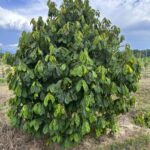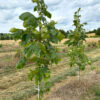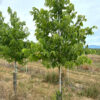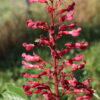For August, we turn to one of the tallest and most massive denizens of the Eastern deciduous forest, the tulip- or yellow-poplar, Liriodendron tulipifera. A member of the magnolia family (Magnoliaceæ)—not Salicaceæ, the willow family, as the common name would suggest, Liriodendron was once a wide-ranging Holoarctic genus that originated in the late Cretaceous period, approximately 90 million years ago. Today the genus is relegated to only two species, our native tulip-poplar and the closely-related Liriodendron chinense, native to central and southern China and northern Vietnam. Tulip-poplar is a common inhabitant of younger forests throughout its range, which extends from Connecticut and the Hudson and Mohawk valleys west through southern lower Michigan and south to eastern Louisiana and north-central Florida. Other than the eastern white pine (Pinus strobus), it is the only eastern native to reach heights in excess of 50m (164 ft). The tallest known living specimen, a tree in the Great Smoky Mountains of North Carolina, was most recently measured at 58.47m (191’, 10”) in 2021.
Liriodendron tulipifera begins life as a coarse, sparsely-branched sapling. It grows rapidly, especially in its favored moist, well-drained, slightly acidic soils, often reaching a height of 25-35 ft (7-11m) within a decade. As the tree matures, it tends to form a straight, branchless trunk with a narrow crown of branches only in the top ½ to ⅓ of its height in forest settings. In the landscape, however, lower branches are more commonly retained, creating a narrowly oval crown which gradually becomes irregular with age. The leaves emerge folded in half along the midrib, gradually unfolding as the petioles strengthen and maturing a bright, glossy green, 3-5 inches (8-13 cm) across with a unique, four-lobed shape. The autumn color is a strong, bright yellow fading to a golden-brown before falling. Cup-shaped, 2” (5 cm) flowers appear in spring, usually in late April or early May in northern Virginia; greenish yellow in color with prominent orange stripes. The flowers are nectar-rich and frequented by bees and other nectar-loving insects as well as hummingbirds and are followed by a cone-like fruiting structure composed of many samaras which are dispersed by the wind in late autumn and through the winter.
The root structure of tulip-poplar is coarse but wide-spreading; nursery-grown specimens are typically regularly root-pruned to create a compact root mass for transplanting. In a landscape setting, the tree works well in large yards, parks, and wide medians; its large size makes it unsuitable for small sites or urban streetside plantings.
Liriodendron is a highly valued commercial timber tree; the pale white wood, tinged with yellow and often streaked with green or grey is light but durable and in high demand for furniture framing as well as painted wood items. While not durable under continual moisture conditions, the trunks were commonly used by Native Americans as dugout canoes as the relatively light wood density improved buoyancy and made the craft easier to carry across portages.
White House Natives has a good supply of Liriodendron tulipifera in 1¾” and 2” caliper for the fall season. It’s a magnificent tree and a stunning specimen for any large site.







